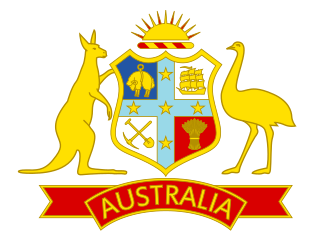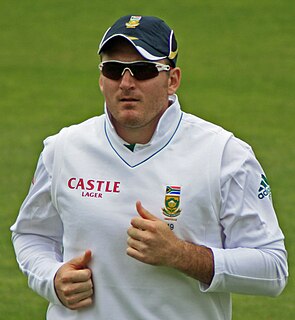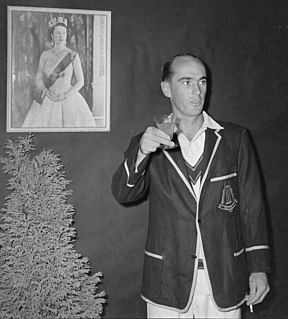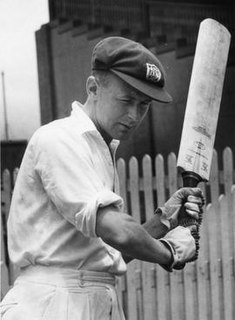Related Research Articles

Sir Donald George Bradman, AC, nicknamed "The Don", was an Australian international cricketer, widely acknowledged as the greatest batsman of all time. Bradman's career Test batting average of 99.94 has been cited as the greatest achievement by any sportsman in any major sport.

The Australia men's national cricket team represents Australia in men's international cricket. As the joint oldest team in Test cricket history, playing in the first ever Test match in 1877, the team also plays One-Day International (ODI) and Twenty20 International (T20I) cricket, participating in both the first ODI, against England in the 1970–71 season and the first T20I, against New Zealand in the 2004–05 season, winning both games. The team draws its players from teams playing in the Australian domestic competitions – the Sheffield Shield, the Australian domestic limited-overs cricket tournament and the Big Bash League.

Graeme Craig Smith is a South African cricket commentator and former cricketer, who played for South Africa in all formats. In 2003, he was appointed captain of the national team, taking over from Shaun Pollock. He held the position of test captain until his retirement in 2014. He is regarded as one of the greatest captains of all time in test cricket. At 22, he was appointed as South Africa's youngest ever captain.

Robert Neil Harvey is an Australian former cricketer who was a member of the Australian cricket team between 1948 and 1963, playing in 79 Test matches. He was the vice-captain of the team from 1957 until his retirement. An attacking left-handed batsman, sharp fielder and occasional off-spin bowler, Harvey was the senior batsman in the Australian team for much of the 1950s and was regarded by Wisden as the finest fielder of his era. Upon his retirement, Harvey was the second-most prolific Test run-scorer and century-maker for Australia.

Ian David Craig was an Australian cricketer who represented the Australian national team in 11 Tests between 1953 and 1958. A right-handed batsman, Craig holds the records for being the youngest Australian to make a first-class double century, appear in a Test match, and captain his country in a Test match. Burdened by the public expectation of being the "next Bradman", Craig's career did not fulfil its early promise. In 1957, he was appointed Australian captain, leading a young team as part of a regeneration plan following the decline of the national team in the mid-1950s, but a loss of form and illness forced him out of the team after one season. Craig made a comeback, but work commitments forced him to retire from first-class cricket at only 26 years of age.

Arthur Robert Morris was an Australian cricketer who played 46 Test matches between 1946 and 1955. An opener, Morris is regarded as one of Australia's greatest left-handed batsmen. He is best known for his key role in Don Bradman's Invincibles side, which made an undefeated tour of England in 1948. He was the leading scorer in the Tests on the tour, with three centuries. His efforts in the Fourth Test at Headingley helped Australia to reach a world record victory target of 404 on the final day. Morris was named in the Australian Cricket Board's Team of the Century in 2000 and was inducted into the Australian Cricket Hall of Fame in 2001.

Thomas Patrick Horan was an Australian cricketer who played for Victoria and Australia, and later became an esteemed cricket journalist under the pen name "Felix". The first of only two players born in Ireland to play Test cricket for Australia, Horan was the leading batsman in the colony of Victoria during the pioneering years of international cricket. He played for Australia in the game against England subsequently designated as the first Test match, before touring England with the first representative Australian team, in 1878. Four years later, he toured England for the second time and played in the famed Ashes Test match at The Oval.

William Harold PonsfordMBE was an Australian cricketer. Usually playing as an opening batsman, he formed a successful and long-lived partnership opening the batting for Victoria and Australia with Bill Woodfull, his friend and state and national captain. Ponsford is the only player to twice break the world record for the highest individual score in first-class cricket; Ponsford and Brian Lara are the only cricketers to twice score 400 runs in an innings. Ponsford holds the Australian record for a partnership in Test cricket, set in 1934 in combination with Don Bradman —the man who broke many of Ponsford's other individual records. In fact, he along with Bradman set the record for the highest partnership ever for any wicket in Test cricket history when playing on away soil
Daren Ganga is a Trinidadian former cricketer. He was a right-handed top order batsman and part-time right-arm offbreak bowler. After debuting as a 19-year-old he has found himself in and out of the West Indian cricket team, playing regularly for and at times captaining the West Indies A side when he was not selected. After being named the 2006 West Indies Players' Association 'Test player of the year', Ganga had for the first time in his career cemented his spot in the side and when captain Ramnaresh Sarwan injured his shoulder in the second Test of their 2007 tour of England, the West Indies Cricket Board turned to Ganga to captain the side for the remainder of the series. Ganga has previously had a chance to hone his leadership from captaining the Trinidad and Tobago and the West Indies Under-23 teams. He can also bowl off spin but he is mainly a batsman.

Marcus James North is a former Australian first-class cricketer who played 21 Test matches and two One Day Internationals (ODIs) for the Australian national side.
An Australian cricket team toured Ceylon and India in 1935-36, playing 17 first-class matches between October 1935 and February 1936, including four unofficial Tests.

Cricket is one of the most popular sports in Australia at international, domestic and local levels. It is regarded as their national summer sport, and widely played across the country, especially from the months of September to April. The peak administrative body for both professional and amateur cricket is Cricket Australia. The 2017–18 National Cricket Census showed 1,558,821 Australians engaged in cricket competitions or programs – an increase of 9% from the previous year. 30% of cricket's participants are now female, and 6 in every 10 new participants are female, one of the highest year-on-year participation growth figures. In terms of attendance figures, more than 2.3 million people attended cricket during the 2017–18 summer, surpassing the record of 1.8 million set in 2016–17.

Mohammad Younis Khan is a Pakistani cricket coach and former cricketer and captain of the Pakistan national cricket team in all three formats of the game, and is widely regarded as one of the greatest middle-order batsmen in Test cricket. Khan is the only Test cricketer in the history of the game to score a century in all 11 countries that have hosted Test matches.
An England cricket team toured Australia in the 1897–98 season to play a five-match Test series against the Australia national cricket team. The team was captained by Andrew Stoddart and, except in the Test matches when it was called England, it was generally known as A. E. Stoddart's XI. The playing strength of the team was weakened by Stoddart acceding to a request from the Australians to bring “new blood”. As a result established players including JT Brown, Albert Ward and Bobby Peel were not selected.

The History of Australian cricket begins over 210 years ago. The first recorded cricket match in Australia took place in Sydney in December 1803 and a report in the Sydney Gazette on 8 January 1804 suggested that cricket was already well established in the infant colony. By 1826, clubs including the Currency Cricket Club, the Military Cricket Club and the Australian Cricket Club had been formed. Hyde Park and the Racecourse were the venue for these organised matches. The formation of clubs in Van Diemen's Land was not far behind with clubs formed in Hobart in 1832 and Launceston (1841). In Western Australia a match was arranged in 1835 between the "builders" of the new Government House and a team of labourers and "mechanics". In Victoria in 1838, the Melbourne Cricket Club was formed – it would become arguably Australia's most exclusive and influential cricket club. In 1839, a club was formed in South Australia.

Joseph Edward Root is an English international cricketer who is the current captain of England in Test cricket. He also represents Yorkshire domestically. As of August 2020 he is ranked in the top ten in both Test and ODI batting in the ICC Player Rankings. Root was part of the England squad that won the 2019 Cricket World Cup.
The Australian national cricket team toured New Zealand in March 1946, playing a single Test match against New Zealand's national team.

The Brunswick Cricket Club is based in Melbourne, Australia. The club was founded over 150 years ago and currently fields four senior men's teams in the Victorian Sub-District Cricket Association along with three senior women's teams and numerous junior sides.
References
- ↑ "Panel selects cricket team of the century". Australian Broadcasting Corporation. 18 January 2000. Retrieved 6 June 2007.
| | This article about a cricket team in Australia is a stub. You can help Wikipedia by expanding it. |